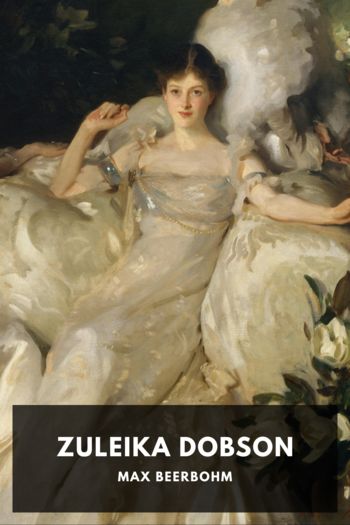The Works of Max Beerbohm - Max Beerbohm (electric book reader .txt) 📗

- Author: Max Beerbohm
Book online «The Works of Max Beerbohm - Max Beerbohm (electric book reader .txt) 📗». Author Max Beerbohm
Be it remembered that long before this time there had been in the heart of Chelsea a kind of cult for Beauty. Certain artists had settled there, deliberately refusing to work in the ordinary official way, and “wrought,” as they were wont to asseverate, “for the pleasure and sake of all that is fair.” Little commerce had they with the brazen world. Nothing but the light of the sun would they share with men. Quietly and unbeknown, callous of all but their craft, they wrought their poems or their pictures, gave them one to another, and wrought on. Meredith, Rossetti, Swinburne, Morris, Holman Hunt were in this band of shy artificers. In fact, Beauty had existed long before 1880. It was Mr. Oscar Wilde who managed her début. To study the period is to admit that to him was due no small part of the social vogue that Beauty began to enjoy. Fired by his fervid words, men and women hurled their mahogany into the streets and ransacked the curio-shops for the furniture of Annish days. Dados arose upon every wall, sunflowers and the feathers of peacocks curved in every corner, tea grew quite cold while the guests were praising the Willow Pattern of its cup. A few fashionable women even dressed themselves in sinuous draperies and unheard-of greens. Into whatsoever ballroom you went, you would surely find, among the women in tiaras and the fops and the distinguished foreigners, half a score of comely ragamuffins in velveteen, murmuring sonnets, posturing, waving their hands. Beauty was sought in the most unlikely places. Young painters found her mobled in the fogs, and bank-clerks, versed in the writings of Mr. Hamerton, were heard to declare, as they sped home from the City, that the Underground Railway was beautiful from London Bridge to Westminster, but not from Sloane Square to Notting Hill Gate.
Aestheticism (for so they named the movement,) did indeed permeate, in a manner, all classes. But it was to the haut monde that its primary appeal was made. The sacred emblems of Chelsea were sold in the fashionable toy-shops, its reverently chanted creeds became the patter of the boudoirs. The old Grosvenor Gallery, that stronghold of the few, was verily invaded. Never was such a fusion of delightful folk as at its Private Views.5 There was Robert Browning, the philosopher, doffing his hat with a courtly sweep to more than one Duchess. There, too, was Theo Marzials, poet and eccentric, and Charles Colnaghi, the hero of a hundred tea-fights, and young Brookfield, the comedian, and many another good fellow. My Lord of Dudley, the virtuoso, came there, leaning for support upon the arm of his fair young wife. Disraeli, with his lustreless eyes and face like some seamed Hebraic parchment, came also, and whispered behind his hand to the faithful Corry. And Walter Sickert spread the latest mot of “the Master,”6 who, with monocle, cane and tilted hat, flashed through the gay mob anon.
Autrement, there was Coombe Wood, in whose shade the Lady Archibald Campbell suffered more than one of Shakespeare’s plays to be enacted. Hither, from the garish, indelicate theatre that held her languishing, Thalia was bidden, if haply, under the open sky, she might resume her old charm. All Fashion came to marvel and so did all the Aesthetes, in the heart of one of whose leaders, Godwin, that superb architect, the idea was first conceived. Real Pastoral Plays! Lest the invited guests should get any noxious scent of the footlights across the grass, only amateurs were accorded parts. They roved through a real wood, these jerkined amateurs, with the poet’s music upon their lips. Never under such dark and griddled elms had the outlaws feasted upon their venison. Never had any Rosalind traced with such shy wonder the writing of her lover upon the bark, nor any Orlando won such laughter for his not really sportive dalliance. Fairer than the mummers, it may be, were the ladies who sat and watched them from the lawn. All of them wore jerseys and tied-back skirts. Zulu hats shaded their eyes from the sun. Bangles shimmered upon their wrists. And the gentlemen wore light frock-coats and light top-hats with black bands. And the aesthetes were in velveteen, carrying lilies.
Not that Art and Fashion shunned the theatre. They began in 1880 to affect it as never before. The one invaded Irving’s premières at the Lyceum. The other sang paeans in praise of the Bancrofts. The French plays, too, were the feigned delight of all the modish world. Not to have seen Chaumont in Totot chez Tata was held a solecism. The homely mesdames and messieurs from the Parisian boards were “lionised” (how strangely that phrase rings to modern ears!) in ducal drawing-rooms. In fact, all the old prejudice of rank was being swept away. Even more significant than the reception of players was a certain effort, made at this time, to raise the average of aristocratic loveliness—an effort that, but a few years before, would have been surely scouted as quite undignified and outrageous. What the term “Professional Beauty” signified, how any lady gained a right to it, we do not and may never know. It is certain, however, that there were many ladies of tone, upon whom it was bestowed. They received special attention from the Prince of Wales, and hostesses would move heaven and earth to have them in their rooms. Their photographs were on sale in the window of every shop. Crowds assembled every morning to see them start from Rotten Row. Preeminent among Professional Beauties were Lady Lonsdale (afterwards Lady de Grey),





Comments (0)